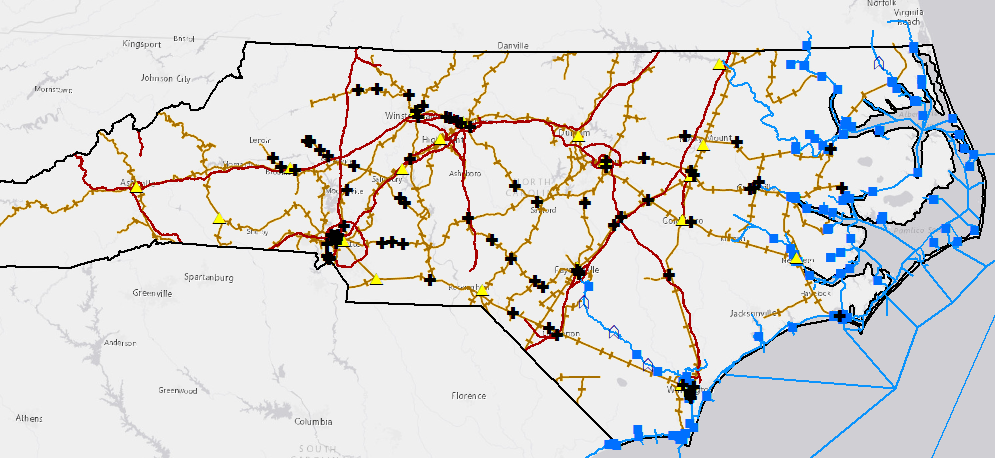Grain Production and Logistics
This is a new area of work and engagement for Agricultural and Resource Economics that began in 2018. The program looks at the NC grain industry and the complex logistics of bringing feed to feed users in the animal industry in NC.
The state sources feed grains in three ways:
- Locally
- From surplus states in the US
- Overseas through the port of Wilmington
The relative cost of importing and producing feed in NC has changed over time and this change creates challenges and opportunities to improve the local supply of grain while keeping feed cost competitive.
North Carolina’s Multi-modal Freight Network

This map shows how agricultural inputs (for example, feed ingredients) and agricultural exports can travel in and out of North Carolina. It also shows how the multi-modal freight transportation system is connected within the state.
After Hurricane Florence these maps were updated to show the freight network along with areas of high feed demand. NCDOT provides real-time road information online, and also via phone through the 511 information line.
Blockchain
Blockchain is a distributed ledger technology expected to minimize transaction costs and improve transparency in the food supply chain. Major food retailers have already partially adopted the technology. Blockchain is currently being applied within many types of agricultural markets: from vegetables, to meat products, to dry bulk commodities.
Key Takeaways for Agricultural Producers
- Many Possible Platforms: There are many blockchain software platforms, and these platforms are not well integrated with each other (or integrated at all).[1] Producers will want to be aware of what upstream businesses are using before investing in any specific platform.
- More Than Shipment Tracking: Blockchain as used in agriculture is not just about tracking shipments but tracking product characteristics throughout the supply chain. Therefore, data input by some producers may be fairly detailed.[2]
- Potential to Get a Higher Price: Some producers are attempting to leverage their use of blockchain to get a higher price in the marketplace.[2] This seems especially pertinent for products that have some quality valued by final consumers but not easily observed.
- Compliance with Food Safety Regulations: The product traceability functionality of blockchain aligns with some parts of food safety regulation.[3]
- Key Functions are Still in Preliminary Stages: Smart contracts are contracts that automatically execute when pre-specified conditions are met. I.e. assets can be automatically exchanged when a delivery, for example, is verified and recorded in the blockchain. These contracts could have bugs or mistakes.[4]
[1] World Trade Organization 2018 Report “Towards a New Digital Era”
[2] NPR 15 August 2018 “Where’s The Beef? Wyoming Ranchers Bet on Blockchain To Track It”
[3] Forbes 25 July 2018 “Blockchain Grains Traction in the Food Supply Chain
[4] European Parliamentary Research Service 2017 “How Blockchain Technology Could Change Our Lives” and Cryptocurrency News 10 October 2018 “Ethereum: We Haven’t Seen the Last of the Bug That Killed DAO”
Electronic Logging Device (ELD) Mandate for Motor Carriers
The ELD mandate went into effect December 2017 and requires commercial drivers to record hours of service electronically rather than in paper logbooks.
Additional Resources
PowerPoint: Futures and Price Risk Management (marketing, hedging, price risk)